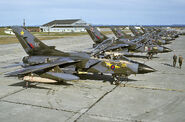| Panavia Tornado | ||
|---|---|---|

| ||
| Description | ||
| Role | Multi-role | |
| Crew | 2 | |
| Passengers | None | |
| First flight | 14th August 1974 | |
| Entered service | 1979 | |
| Manufacturer | Panavia Aircraft GmnH | |
| Produced | 1979-1998 | |
| Dimensions | ||
| Length | (IDS/ECR) 54 ft 9.5 in (ADV) 61 ft 1 in | (IDS/ECR) 16.7 m (ADV) 18.62 m |
| Wingspan | 45 ft 7.5 in spread, 28 ft 2.5 in swept | 13.91 m spread, 8.56 m swept |
| Height | 19 ft 6 in | 5.95 m |
| Wing area | 286.3 sq ft | 26.6 sq m[1] |
| Weights | ||
| Empty | (IDS) 30,864 lb (ADV) 31,967 lb | (IDS) 14,000 kg (ADV) 14,500 kg |
| Take off, Clean, max internal fuel | 45,000 lb | 20,410 kg |
| Maximum takeoff | 61,729 lb | 28,000 kg[1] |
| Powerplant | ||
| Engine | See entry | under variants |
| Power (each) | See entry | under variants |
| Internal Fuel | (Standard IDS) 5,842 litres in fuselage and wing tanks. (RAF/RSAF IDS) As standard, plus tank in fin, increasing capacity to 6,393 litres. | (ADV) 7,270 litres[1] |
| External Fuel | See entry | under variants |
| Performance | ||
| Maximum speed | Mach 2.2 clean | Mach 1.8 with stores |
| Cruising speed | 921 mph | 1,482 km/h |
| Range | See Notes | |
| Ceiling | (IDS) Above 50,000 ft (ADV) 70,000 ft | (IDS) Above 15,240 m (ADV) 21,300 m[1] |
| Rate of climb | ||
The Panavia Tornado is a twin engine, variable sweep wing combat aircraft developed by the United Kingdom, Germany and Italy.
Description[]
There are three basic variants of the tornado. the IDS (interdictor/strike) ADV (air defence variant) and ECR (electronic combat/recon). The Tornado saw action in the 1991 Gulf War, the Bosnian War, Kosovo War and the Iraq War. Used in smaller roles in Afganistan and Yeman, it can be equipped with enhanced Pavewave LGBs, Joint Direct Attack Munition Bombs, modern cruise missiles like Taurus, and Storm Shadow. It also can be armed with air-to-air missiles such as the AIM-9 Sidewinder or AIM-132 ASRAAM. The Tornado can also use Skyflash and AIM-120AMRAAM. The Italian and German Tornado's can use B61 nuclear bombs. The IDS has two 27 mm Mauser BK-27 revolver cannons mounted underneath the fuselage but the Tornado ADV only has one. Operators of the Tornado are Germany, Italy and Saudi Arabia. former operators are the the United Kingdom (retired all tornados in 2019)
Notes[]
Range is dependent of variant and circumstances, as follows:
- IDS interdiction radius, Lo-Lo-lo-Lo: 691 miles (1,111 km)
- IDS interdiction radius, Hi- Lo-Lo-Hi: 921 miles (1,482 km)
- IDS maritime attack radius, Hi-Lo-Lo-Hi: 806 miles (1,296 km)
- IDS ferry range: 2,360 miles (3,797 km)
- ADV subsonic point intercept range: 1,036 miles (1,667 km)
- ADV supersonic point intercept range: 230 miles (370 km).
The first two refer to aircraft with four 1,000 lb bombs, two Sidewinders and two drop tanks. The last two refer to aircraft with four Sky Flash missiles, four Sidewinders, gun with ammunition and two drop tanks.[1]
Variants[]
- IDS: Standard bomber version. Used by Germany, Italy and RSAF. Two Turbo-Union RB199 Mk 103 turbofans. Ratings - 9,100 lbf (40.5 kN) dry, 16,000 lbf (71.2 kN) with afterburner.
- GR Mk 1: Basic RAF aircraft, later upgraded to GR Mk 4 standard
- GR Mk 1A: RAF reconnaissance aircraft, later upgraded to GR Mk 4A standard. Also used by RSAF
- GR Mk 1B: RAF maritime strike aircraft.
- ECR: Electronic combat aircraft, used by Germany and Italy (Italian examples converted from IDS aircraft). Two Turbo-Union RB199 Mk 105. Ratings - 9,550 lbf (42.5 kN) dry, 16,700 lbf (74.3 kN) with afterburner
- ADV: Long range air defence version. Used by RAF, RSAF and Italy. Two Turbo-Union RB199 Mk 104. Ratings - 9,100 lbf (40.5 kN) dry, 16,410 lbf (73 kN) with afterburner. [1]





